How To Play Scales On The Guitar: Unleash your soloing power! Learn guitar scales and play like a pro.
Table of Contents
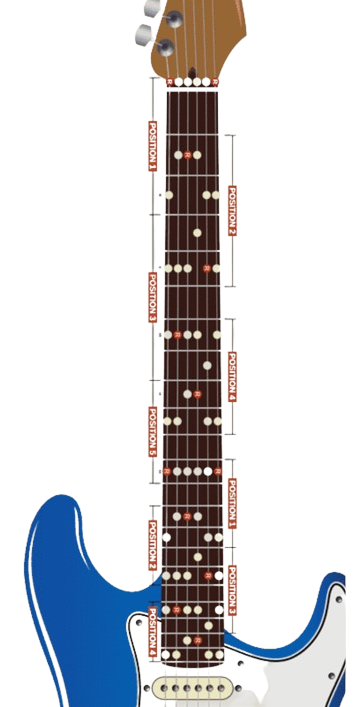
Hi! Ian here, and welcome to this crash course in conquering the guitar fretboard (without, like, becoming a total shred-lord… yet!).
Ever heard someone casually toss out phrases like “major scale” or “pentatonic” and felt your brain do a confused backflip? Don’t worry, my friend, you’re not alone. But fear not!
Today, we’re diving headfirst into the electrifying world of guitar scales, and by the end, you’ll be transforming those confusing terms into tools that unlock musical mastery.
Think of scales as the building blocks of music. They’re the secret sauce behind your favourite songs, from heart-wrenching ballads to face-melting riffs. Learning them might seem daunting, but trust me, it’s like learning the alphabet of guitar.
Once you have the basics down, you’ll be unlocking endless possibilities for writing your own music, improvising solos, and understanding the music you love even better.
Now, I know what you’re thinking: “Ian, there are, like, a million scales out there. Where do I even start?” Relax, grasshopper! We’re gonna keep it super chill. We’ll focus on two essential scales that are perfect for beginners: the E minor pentatonic and the C major scale. Don’t let the fancy names scare you – these guys are super approachable and will lay the foundation for your future guitar hero journey.
But before we dive into the nitty-gritty, let’s grab some essentials. You’ll need your trusty guitar (acoustic or electric works!), a tuner (to make sure your notes sing, not scream!), and an open mind ready to rock. Bonus points for a comfy chair and a healthy dose of patience – remember, guitar mastery takes time and practice, but hey, the journey is half the fun!
So, are you ready to embark on your guitar scale adventure? Buckle up, because in the next chapter, we’ll be getting our fingers familiar with the fretboard and learning how to play those first magical notes. Stay tuned, and remember, have fun and keep strumming! Oh, and for even more awesome tips and tricks, check out JustinGuitar (justinguitar.com) – it’s a treasure trove of free guitar lessons for all levels. See you there!
Understanding Guitar Scales
In exploring guitar scales, you’re diving into the foundation of melody and harmony on your instrument. Grasping the structure and logic behind them will expand your musical vocabulary on the fretboard.
Fundamentals of Scales
A scale in music is a set of notes ordered by pitch, typically within an octave, which is a series of eight notes spanning from a root note up to its double-frequency counterpart. On the guitar, this process involves playing notes across strings and frets in a pre-defined sequence. Whole steps and half steps between these notes determine the unique sound of each scale.
For example, drawing from Scales Explained – Theory, Diagrams and Everything You Need to Know, to play a scale, you would follow specific fretboard patterns that include whole steps (two frets apart) and half steps (one fret apart). The starting point or the root note of a scale is crucial, as it gives the scale its name and tonal centre.
The Role of Scales in Music
Scales form the bedrock of music theory, serving as the alphabet from which melodies, chords, and solos are constructed. They help you understand the relationship between notes and how they fit together to convey different emotions and musical ideas. For instance, the Major scale is fundamental in Western music, creating a bright, happy sound, while the Minor scale imparts a sadder, more contemplative emotion.
Furthermore, scales are essential for improvisation. Being familiar with scales means you can confidently navigate the fretboard and express yourself musically over various chord progressions and in different keys. Mastery of scales lays the groundwork for advanced concepts like modes and can greatly enhance your playing agility and creativity.
Types of Guitar Scales
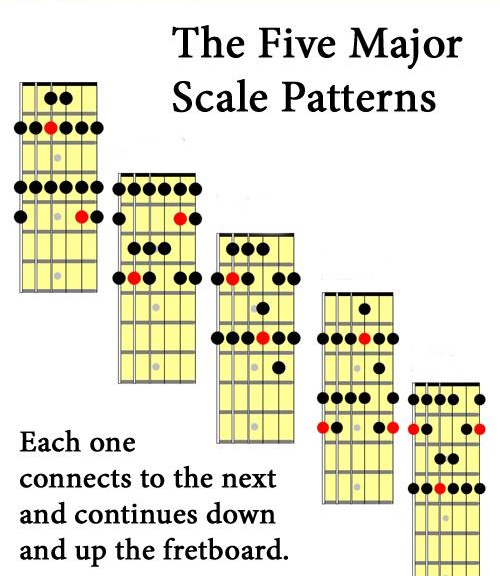
Guitar scales are the building blocks of music, enabling you to navigate the fretboard and create melodies. They come in various forms, each with its own distinctive sound and emotional expression.
Major and Minor Scales
Major Scale: Often referred to as the Ionian mode, the major scale is comprised of seven distinct notes and is known for its bright and happy sound. The C major scale, which uses natural notes (no sharps or flats), is commonly the first scale guitarists learn.
Examples: C Major – C, D, E, F, G, A, B, C
Minor Scales: The natural minor scale, or Aeolian mode, contains seven notes with a more sombre and reflective feel compared to major scales. Additionally, the harmonic minor scale brings a classical vibe with a raised seventh note, whereas the melodic minor scale ascends with a raised sixth and seventh but descends in the natural minor form.
Examples: A Minor – A, B, C, D, E, F, G, A
Pentatonic Scales
Pentatonic Major Scale: This scale is a five-note version of the major scale, omitting the fourth and seventh degrees, providing a simplified yet versatile sound palette.
Examples: C Major Pentatonic – C, D, E, G, A, C
Pentatonic Minor Scale: The minor pentatonic scale is arguably the most used in rock and blues genres. It’s derived from the natural minor scale by removing the second and sixth degrees.
Examples: A Minor Pentatonic – A, C, D, E, G, A
Blues and Jazz Scales
Blues Scale: The blues scale adds a flattened fifth, or ‘blue note’, to the minor pentatonic, evoking the characteristic sound of blues music.
Examples: A Blues – A, C, D, D# (Eb), E, G, A
For jazz, scales like the Dorian, Mixolydian, and Lydian modes provide the necessary chromaticism and tension integral to the genre.
Exotic Scales
Exotic scales, such as the Phrygian and Double Harmonic scales, offer unique intervals that differ from Western music, commonly used in Middle Eastern, Asian, and Eastern European music to convey particular atmospheres and ethnic sounds.
Examples: E Phrygian – E, F, G, A, B, C, D, E
Each type of guitar scale unlocks different moods and styles, allowing you to express various musical emotions and themes. As you become more familiar with these scales, your versatility and expressive capacity will expand significantly.
Scale Patterns and Positions
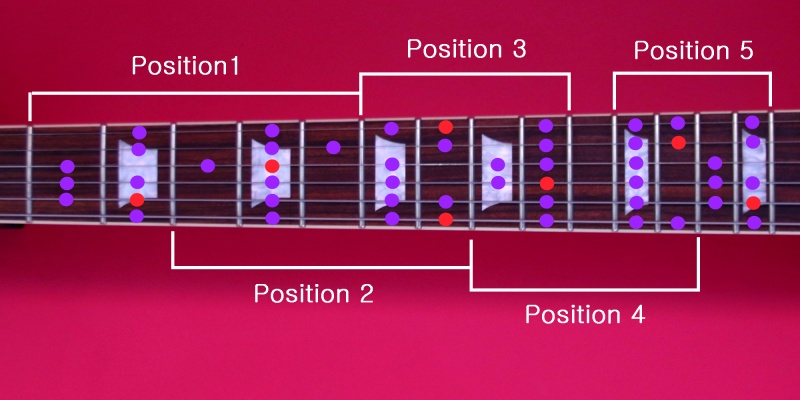
Mastering scale patterns and positions is crucial for fluidity and versatility in your guitar playing. Understanding these concepts allows you to navigate the fretboard with ease and express musical ideas across various keys and genres.
Learning Common Patterns
Scale patterns are visual and physical representations of the notes within a scale. They provide you with a roadmap for creating melodies and can be repeated in different positions on the fretboard. One essential pattern to learn is the major scale pattern, which follows the sequence of a whole step, whole step, half step, followed by three more whole steps and a final half step. These steps translate to fret distances on your guitar, with a whole step equating to two frets and a half step to one fret. By learning these major scale patterns, you establish a foundation that many other scales and modes are built upon.
Navigating the Fretboard
To navigate the fretboard confidently, you should familiarise yourself with scale diagrams. These diagrams visually map out where each note of a scale can be played across the strings and frets. By using moveable scale patterns, you gain the freedom to play in any key by shifting the same pattern to the desired root note’s starting point. Familiarity with the CAGED system can be a helpful way to structure your understanding of the fretboard.
Positional Playing
Positional playing outlines a method where you play a scale within the span of a few frets, usually four or five, allowing you to play scales without moving your hand much. These one-position major scale shapes can be moved up or down the neck to play the same scale in different keys. Each position has its unique pattern, and learning these will increase your muscle memory and dexterity. Once you are comfortable, you can use moveable patterns to expand your playing into different keys. For instance, you have seven major scale positions, each starting on a different degree of the scale, that you can practice to familiarize yourself with the whole neck.
Playing Scales on the Guitar
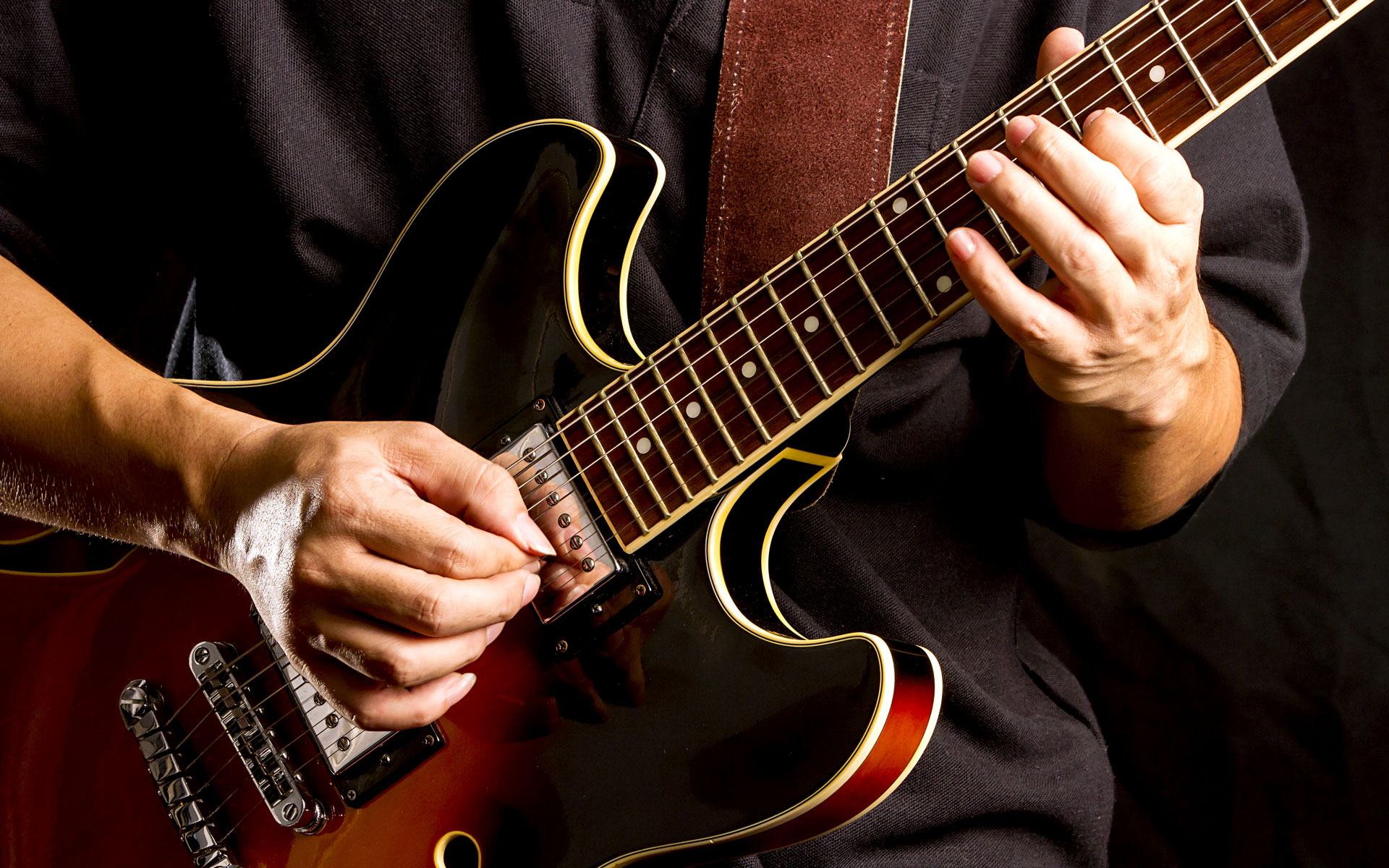
To master guitar scales, a combination of proper technique and an understanding of the mechanics behind ascending and descending the fretboard is essential. Acquiring these skills will elevate your ability to navigate scales confidently.
Techniques for Ascending and Descending
When you ascend a scale, you play notes from the lowest to the highest pitch in sequence. Your fingers should press down just behind the frets, using minimal pressure to produce a clear tone. Start slowly and gradually increase your speed as you become more comfortable with the finger placements. Conversely, descending involves playing the scale from the highest to the lowest note. Ensure that you use the same fingerings as you used when ascending to maintain consistency and muscle memory.
- Ascending:
- Start with the lowest note, usually with your index finger.
- Proceed sequentially to the next notes, utilising all available fingers.
- Descending:
- Begin with the highest note of the scale.
- Move in reverse order, returning to the lowest note.
Alternate Picking Techniques
Alternate picking is a fundamental guitar playing technique that involves using your pick to strike the strings in an alternating down-up motion. This technique allows for greater speed and efficiency when playing scales. It’s crucial to keep your picking hand relaxed to facilitate smoother movements across the strings.
- Alternate Picking:
- Begin with a downstroke on the lowest string and follow with an upstroke.
- Continue this pattern, maintaining alternate down and up motions.
Focus on the precision of your picking, ensuring you strike each string with equal force and clarity. As you gain proficiency, incorporate different picking sequences to challenge your dexterity and improve your control when transitioning between strings. Remember, consistent practice is the key to mastering these techniques.
Practical Applications of Guitar Scales
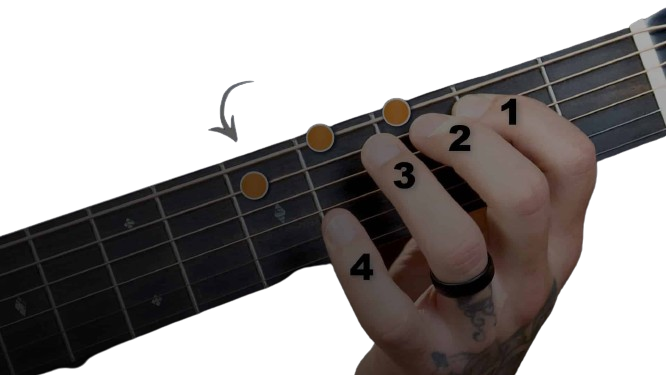
Guitar scales are not just exercises; they’re the foundation for most aspects of guitar playing, from crafting solos to improvising over chord progressions. Understanding how to apply scales will enhance your ability to create, express and communicate musically.
Using Scales for Improvisation
When you’re ready to improvise, scales provide the musical vocabulary you need. You’ll typically select a scale that matches the overall key of the piece or one that complements the current chord progression. This ensures that the notes you play sound harmonious. For instance, over a C major chord, you might improvise using the C major scale. However, soloing over a chord progression often involves more than one scale. In jazz, for instance, it’s common to change scales with each chord to outline the harmony.
Creating Melodies and Solos
Scales are crucial for creating melodies that make your music resonate with listeners. As you develop familiarity with scales, you’ll learn to string notes together in a way that sings. The minor pentatonic scale is widely used for creating catchy riffs and powerful solos due to its simplicity and emotional impact. Each scale degree can suggest a feeling or direction, and through practice, you’ll discover how to craft melodies that truly express your musical ideas.
Backing Tracks and Jamming
Practising with backing tracks is an excellent way to apply guitar scales. These tracks give you a rhythmic and harmonic context for exploring different scales and styles of playing. Jamming, whether with backing tracks or other musicians, allows you to test your scale knowledge in a dynamic setting. The interplay between the chord progressions of the backing track and the scales you choose is a fertile ground for improvisation, helping you learn how to phrase your solos in real-time.
Guitar Scale Exercises
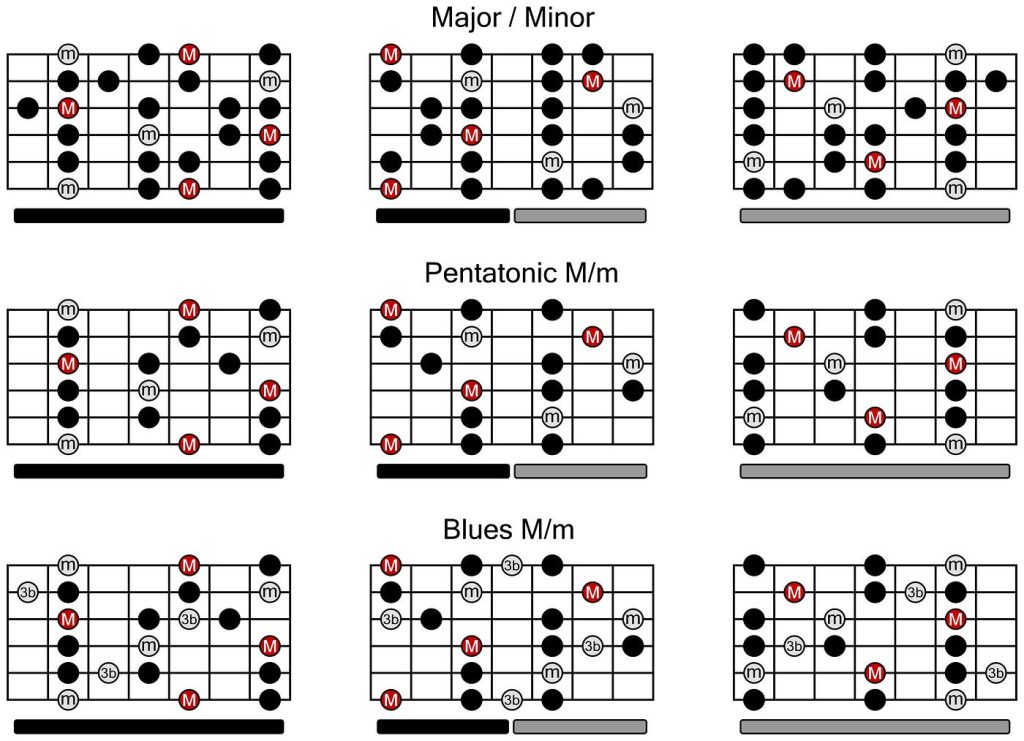
Developing expertise in playing scales on the guitar requires focused exercises that enhance both your speed and accuracy. Utilise a metronome to pace your practice and systematically increase your speed, ensuring your technique remains clean and precise.
Building Speed and Accuracy
To build speed, start by setting your metronome to a slow tempo where you can play the scale comfortably without mistakes. Incrementally increase the tempo, usually by 5 to 10 beats per minute, as you gain confidence and maintain accuracy. Consistency is key, so practise exercises like the classic “four-note groupings” where you play four consecutive notes of the scale, then move to the next note in the scale and play another four. Repetition of such patterns will train your fingers to move swiftly and with precision.
Be attentive to clean finger placement and transition between notes. Minimise tension in your hands and ensure your picking technique is economical; this means using minimal movement for picking and fretting, which will help you play faster.
Integrating Scales into Practice Routines
Incorporate scales into your daily practice routine to solidify your lessons and muscle memory. Aim for a balanced approach where scales are not simply an isolated drill but rather a musical exercise integrated with other components of guitar playing. For example, you can use scales to practise chord-to-scale connections, which involves playing a chord and then immediately playing the corresponding scale.
Make sure each practice session includes a variety of scales. Work on both the major and minor scales, as well as pentatonic and modal scales, enabling you to become versatile across musical genres. Regularly revisiting these exercises will ingrain the scales in your playing, providing a foundation for improvisation and more advanced guitar work.
Music Theory for Guitarists
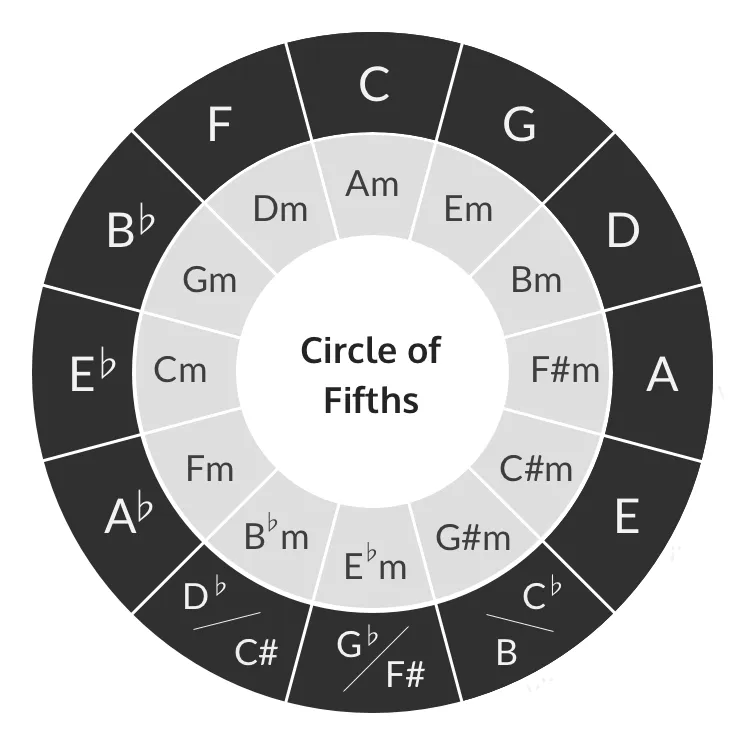
In this section, you’ll gain a fundamental understanding of music theory tailored for guitarists, focusing on intervals, chord progressions, and the use of modes in creating musical harmony.
Understanding Intervals and Chord Progressions
When you begin learning guitar, it’s essential to understand that intervals are the building blocks of chords and chord progressions. An interval refers to the distance between two notes, measured in semitones or tones on your fretboard. For instance, if you play an open A string and then the note on the 2nd fret, you’ve played a major second interval.
Chord progressions are a series of chords played in a sequence. These progressions add emotional depth and narrative to your playing. Here’s an example of a common chord progression in the key of C major:
- C Major (I)
- A minor (vi)
- F Major (IV)
- G Major (V)
This progression follows a I-vi-IV-V pattern and is the basis for numerous songs as it establishes a pleasing harmonic rhythm.
Modes and Modal Playing
Guitarists will often venture from standard major and minor scales into the colourful world of modes. Modes are variations on the major scale that start on different notes of the scale. Each mode has a unique pattern of intervals, giving them distinctive sounds. The seven modes derived from the C Major scale are as follows:
- Ionian (C-D-E-F-G-A-B)
- Dorian (D-E-F-G-A-B-C)
- Phrygian (E-F-G-A-B-C-D)
- Lydian (F-G-A-B-C-D-E)
- Mixolydian (G-A-B-C-D-E-F)
- Aeolian (A-B-C-D-E-F-G)
- Locrian (B-C-D-E-F-G-A)
For example, the Dorian mode starts on the second note of the major scale and is characterised by a minor third and major sixth, creating a jazzy sound. Modal playing involves utilising these modes to improvise or compose, drastically changing the mood and atmosphere of your music.
Frequently Asked Questions
What are the initial steps to learn guitar scales for beginners?
Firstly, familiarise yourself with the basic layout of the fretboard and the finger numbering system, which is crucial for fretting the correct notes. Start with simple scales like the major pentatonic to gradually build up your technique and knowledge.
In which order should I learn the major scales on the guitar?
As a framework, begin with the C major scale since it has no sharps or flats, making it easier to grasp. Then progress through other scales by following the Circle of Fifths, which outlines the key signatures systematically.
How can I understand and memorise different scale patterns on the guitar?
To effectively memorise scale patterns, break them down into sections and practice each one slowly. Make use of scale diagrams and concentrate on one scale shape at a time until it becomes second nature. Recalling scales can also be bolstered by understanding the intervals within each scale.
Can you illustrate how to utilise tabs when practicing guitar scales?
Tabs, short for tablature, display which frets to hold down on which strings. They are read from left to right, with numbers representing frets. For example, ‘0-2-4’ on a tab would mean you play the open string, then the second fret, and then the fourth fret sequentially on the same string. Practising scales using tabs can help visualise the fretboard layout.
Conclusion
Shred With Confidence: Scale Conquerin’ Made Fun!
So, you’ve tackled the frets and learned your chords, and now those mysterious “scales” beckon. Don’t fret (pun intended!), mastering scales isn’t just about finger acrobatics. It’s the secret sauce to unlocking improvisation, understanding music theory, and making your solos sing!
Think of scales as musical building blocks. Learn a few, and suddenly, chords you already know transform into cool riffs and melodies. Plus, you’ll impress your friends with your newfound fluency (because let’s face it, who doesn’t love showing off?).
Start with the E minor pentatonic scale. It’s easy to learn, sounds fantastic, and works in countless genres. Check out JustinGuitar’s website (https://www.justinguitar.com/) for beginner-friendly video lessons that will have you rocking in no time.
Remember, scales are a journey, not a destination. Be patient, practice regularly (even 10 minutes a day makes a difference!), and most importantly, have fun! Experiment, jam along to your favourite songs, and don’t be afraid to make mistakes. After all, the coolest solos often come from happy accidents.
So grab your guitar, crank up the music, and get ready to shred! You’ve got this!
